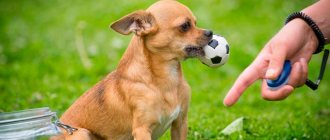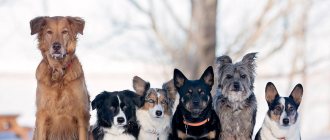The German Shepherd is a working dog. This means that her temperament, ability to acquire new knowledge, senses and constitution are focused on a single goal - serving the owner.
But the owner himself must understand that he will have to fulfill a number of requirements in order to raise an obedient and well-mannered German Shepherd. To do this, you will have to make an effort on your part, because the owner must become both a leader and a friend for the shepherd.
Otherwise, the innate positive qualities of the BUT will acquire negative properties, which will greatly complicate the cohabitation of a person and a shepherd dog in the same area, be it a city apartment or a private house.
To avoid such a situation, it is not enough to exercise a German Shepherd from time to time, feed it according to a schedule and walk it 4-6 hours a day; it must be raised correctly.
Raising a German Shepherd puppy begins from the first day of settling into its new home!
Beginning of education - socialization
These are two pillars that are inextricably linked to establish a strong bond between the owner and his pet.
Without proper socialization, further education of a German Shepherd is impossible.
Without proper upbringing, a German Shepherd will not be able to master the initial training course and successfully demonstrate its abilities at the final stage - ZKS or sports tests.
Without the initial socialization of the puppy, its further upbringing and completion of the training course at the appropriate time, not a single BUT will be recognized as a full member of human society.
What does "socialization" mean?
Between one month and two months is the ideal time to buy a puppy - a dog's child is especially curious and friendly. Thanks to this, he has no problems forming contacts with people and other pets.
Tolerance of another species is also socialization!
During this period, it is easy to “make friends” between a puppy and a kitten, especially if both are about the same age and both came into the house recently
. A kitten at the age of 2-3 months does not yet need personal space and, just like a puppy, loves to run and play, and they are not yet capable of causing serious injuries or scaring each other.
Serious disputes between “children” can arise over food - the puppy will most likely try to drive the kitten away not only from its own bowl, but also from its bowl. Feed the animals at the same time, and space out the bowls at different heights.
True friendship (in the human sense) will not arise between playmates, but the feeling of a “friendly shoulder” will persist for many years.
A matured kitten will eventually move away from its grown-up friend, but a barking baby will gain rich experience in communicating with an animal of another species (including humans) - a huge positive contribution to the socialization process.
What are social skills for?
By exploring a new environment, meeting new people, animals, sounds, objects and concepts, acquiring new knowledge and skills, BUT puppies develop fully, training their brains, developing control over their actions and emotions, stimulating the development of innate instincts.
Consolidating new knowledge with correct behavioral reactions builds self-confidence in the puppy - resistance to stress.
The resistance of the central nervous system to external stimuli leads to the development of innate instincts and unconditioned reflexes (automatic behavior characteristic of animals), without which further steps in education and training are impossible.
The owner’s task during this period is to be nearby, communicate, show miracles of patience, encourage and protect.
Without human support, the OI will never be able to realize itself socially in human society; it will become aggressive and cowardly and will forever lose valuable working qualities.
Socialization of a puppy is psychophysiological preparation for further education.
How to train a dog?
To the toilet
Puppies are taught to go to the toilet outside at the age of 2-3 months after vaccinations. Certain rules must be followed:
- After waking up, eating, or if the puppy begins to fidget and sniff the floor, he is taken outside.
- You need to choose a secluded place on the street.
- A successful trip to the toilet is rewarded with a treat.
- After this, they go home only after the dog has had enough of playing outside.
Follow the trail
This requires treats and the help of someone from the family.
- The owner moves away from the dog at a distance of no more than 2 meters. Treats are placed in the places where he steps.
- The dog is given the command “Look” and collects all the treats.
- After a few tries, you should reduce the number of treats. The shepherd must learn to track the scent on its own.
- Training should be done every other day or every few days.
- Gradually the task becomes more difficult. The owner can walk in zigzags and in different directions.
Proper education
Education has already begun along with socialization and the development of the first conditioned reflexes.
And successfully raising a shepherd puppy, obtaining a stable and sustainable result, will help with knowledge about the behavior and inclinations of animals of this species, inherited from their distant ancestors.
What the owner needs to firmly understand
Raising a shepherd dog must begin with one’s own self-education, so as not to make mistakes that will then have to be corrected “with sweat and blood”:
- A shepherd dog cannot think like a human!
She doesn't care about the future or the past. She cannot write poetry or compose music - they have no imagination and fantasies. They think “here and now.” - The Shepherd always follows the path of least resistance, preferring the pleasant to the unpleasant
. Within this framework, she builds her behavior using her previous experience. This quality is always beneficially used in education and training. - Shepherd dogs are well aware of their strength and know how to use it
. They are good observers and, on occasion, willingly demonstrate their superiority. - The shepherd is a herd animal
. They love communication, know how to adapt to new conditions, and easily fit into various social structures. The owner’s task is to convince the German Shepherd that he has found himself in a new pack, where the owner = leader. - You cannot demand from a shepherd the difference between the concepts of “good” and “bad”.
She distinguishes between “possible” and “impossible” - this is a fundamental postulate for the owner in the process of education. You need to raise and train your shepherd in such a way that an action you don’t need becomes unpleasant for her and, as a result, forbidden. - The shepherd dog does not understand human language, and accordingly cannot speak or think in it.
A rapidly developing shepherd dog is able to learn several words and phrases (which is the basis of education and training), spoken in the same tone, reinforced by repeated gestures of your hands, facial expressions, posture, etc. Intonation is an absolute indicator of its correct or incorrect behavior. If your German Shepherd puppy does not listen, then you have not conveyed the correct information to him. - The owner, in turn, must learn to understand canine language (and the language of postures and gestures!) in order to distinguish what makes his pet bark, grumble, whine and howl.
- The actions of your German Shepherd will become much clearer if you understand that he does not live “with a family”, but in a pack.
Then the question: “Is it possible to beat a puppy in the process of training?” - will disappear by itself. In a pack, the unreasonable are punished, but dogs cannot hit someone - they do not have hands or the ability to strike with any object. - The “pack territory,” with proper upbringing, will become sovereign territory with age, which the shepherd will be ready to defend until its last breath.
If in this territory the leader “tolerates” a stranger or a new animal, the young dog will also learn to tolerate him. - A dog's reactions are based on reflexes and instincts
. During the training process, do not transfer the logic of human actions to the behavior of your shepherd. The peculiarities of raising a puppy and a child differ in that the child can be explained where he is wrong, but it is useless to have conversations with Canis lupus (lat.). You will have to learn to understand the behavior of your German Shepherd and look for and correct your own mistakes.
If you know how your shepherd will behave in a particular case, you can “predict” the reaction of your dog, which is easy to use when raising a puppy in a friendly environment.
These rules are immutable, you need to know them and be sure to follow and take them into account if your goal is to raise an obedient, well-mannered German Shepherd, a reliable friend and companion.
However, despite all the reflexes and instincts, every good owner knows that sometimes his pet exhibits feelings that cannot be interpreted as purely reflexive actions.
Dogs have more than intelligence and reactions - affection and love. In a dog's understanding, of course.
At what age should you start?
Dog training begins early: already in the first days after arriving at its new home, the shepherd dog gets used to its name, place, toilet and begins to learn the first simple commands, such as “Come to me” or “No”.
Later, the growing dog must learn other basic commands, as well as learn how to behave correctly in a given situation..
Experts recommend moving on to more serious general training courses at the age of about six months, and it is better to train a shepherd dog in a group or individually under the guidance of an experienced dog handler.
Care and basics of education
Care and education are inextricably linked. When caring for a German Shepherd puppy, you, wittingly or unwittingly, are teaching him the basics of education.
For example, when feeding, you tap the bowl, and then call the puppy to you, pronouncing the name loudly and clearly. After 2-3 days, the baby will begin to run up as soon as he hears the familiar tapping.
But he won’t get food (the bowl in your hands is raised to the level of his head) until he stops spinning and places his butt on the floor. At the same time, you give the command: “Sit!”, and after a couple of days the puppy will run up and sit down automatically.
While the brain of a small creature is receptive only to simple commands, so at first the execution of commands will be symbolic. Let be!
But in a short time you will develop strong reflexes in your baby to his own name, calling and the command: “Sit!”
The German Shepherd puppy will learn to associate your voice with receiving pleasant things (food, praise, games, affection), and you will win the right to be called the leader, who is given the power to execute or have mercy.
What must be included in the care and education plan
In addition to accustoming the puppy to himself and developing simple reflexes, the owner’s plan should include the following points:
- Monitoring the physical and mental development of the puppy.
- Observation of natural excrements (stool).
- Mandatory presence during feeding.
- Proper placement of food and water bowls.
- Stay in the air for at least 4 hours a day.
- Observing the relationship between the puppy and other family members.
- Observing the relationship between the puppy and other animals (including strangers’ dogs encountered while walking).
- Puppy protection.
- Daily cleaning and examination of skin, teeth, claws and ears.
- Carrying out preventive vaccinations according to age.
- Cleaning and disinfecting the puppy's area.
- The correct selection of items for play and walking, including a collar and leash.
- Maintain personal hygiene.
Character of the breed
Raising a German Shepherd is not difficult even for novice dog breeders. This breed is one of the three smartest. She learns a new command in less than 5 repetitions, and 95% of the time she executes it the first time.
German Shepherds are obedient and people-oriented. One of their key qualities as service dogs is the ability to obey not only the owner, but also new handlers, to whom the animals quickly become attached.
Other breed qualities also make the Shepherd an excellent student:
- equilibrium;
- calm;
- Confidence in your strength;
- ability to quickly adapt;
- sensitivity - dogs detect the slightest changes in human behavior;
- high security and protective capabilities;
- physical endurance;
- flexible psyche.
Therefore, shepherd dogs cope with any type of activity. There is no area where they are not used. They serve as assistants to shepherds, for the protection of the territory, search and rescue service, and protection. Pets are often used by police, firefighters and border guards. They are also excellent companions and guides.
Education, care and training
The simplest technique, combining education and care, with an element of training, is to teach a 4-6 week old puppy to give a paw
. This is a very useful technique!
The puppy's ability to extend its paw is related to the reflex to massage the mother's nipple, stimulating milk supply. Therefore, teaching this technique is not difficult.
Take a piece of treat in your hand, and with the other hand pull the baby’s paw towards you, repeating: “Give me your paw!” As soon as the baby calmly reacts to the position of his paw in your hand, give the puppy a treat and praise him. After 2-3 receptions, the puppy will offer his paw himself, for which he will have to sit opposite you.
Video on how to teach a shepherd to give a paw
While your pet is chewing a treat and sitting on 3 legs, you can quickly examine its ears, the condition of its claws, pink belly and armpits - places where signs of allergic urticaria, insect bites or scratching appear earlier than on other parts of the body.
Basic mistakes
The most common mistakes when training German Shepherds:
- Classes are conducted without taking into account the individual characteristics of the dog.
- Lack of consistency: This occurs if the puppy is taught complex commands first and then simpler ones.
- Classes are held in an inappropriate place where there are many distractions, which is why the pet cannot concentrate.
- Commands are given in a certain sequence, which is why the shepherd dog has an algorithm for their execution. And, having heard, for example, the command “Sit!”, she immediately lies down on her own.
- All commands are given in a threatening tone, although the puppy is not doing anything wrong.
- Classes are held with long breaks, which is why the pet manages to forget what was previously learned within a few days without training.
- The demands placed on the dog are too great.
After three months, you need to give the dog a treat only the third time after correctly executing the command, and the remaining times just praise him.
We play and educate
In the game, you can begin to practice the skills of following the owner, the command: “Come to me!”, looking for objects, bringing a ball or favorite toy, and being calm about the collar and leash.
In the game, the baby will learn to give his paw, to correctly grab a rag without catching it with his front incisors, but to take it deep into his mouth, to give a voice on command, and will receive his first lessons in basic training.
You should play and exercise an hour and a half before feeding, so that the puppy is in a cheerful mood and wants to get a treat.
If the baby is overexcited and cannot tune in to your attention, stop giving commands, but do not praise or encourage the naughty child - pretend that you do not notice him. After some time, when the puppy moves towards you, call his name and say in an even voice: “Come to me!” When he runs up and perhaps sits down, then express your delight at his behavior and be sure to encourage him.
At 1 month, a German Shepherd puppy already knows for sure that when called it should run up to its owner, and at 2 months it should run up and sit down.
How to play correctly
There is no need to consolidate what has been achieved with three to five repetitions - unconditional execution of commands will begin a little later. For now, the scheme is enough: did the right thing - received praise and a treat; didn't do it - got nothing.
Scolding or punishing a child for failure to follow or unclear execution of a command at such a young age is unacceptable!
The worst thing you can do for your pet is to instill fear in him before exercise or extinguish the dog's natural intelligence.
To prevent this from happening, do not let him overwork. If the child did the exercise correctly, be sure to praise him once; and immediately invite the puppy to play, switching his attention - two.
A point that owners often miss during play: the puppy should always come out a winner!
Tugging a rag or stick - feel when the toy begins to get tired and give the object to him to be torn to pieces.
A ball or a doll - the puppy is tired of running after them or looking for them. Find it yourself, show him the find and give it back, after a very short “struggle”.
If a curious animal has found something and does not want to part with it, there is no need to run after it, trying to take it away. On the contrary, walk in the opposite direction, turning around from time to time and calling the puppy BUT by name. He will definitely follow you! As soon as he runs up, we immediately praise him for his obedience, give him a treat, put him on a leash (a treat again!) and walk away, offering the puppy a new game. For example, “catch up with the owner!”
If during the classes you were unable to learn something new, at the very end repeat 2-3 exercises that the child has learned well and does with pleasure, and you are happy to praise and encourage him for this. “Lessons” should end only with positive emotions!
The final stage is to let the puppy choose the game himself, with the participation of the owner, of course.
How to tame?
A puppy is much easier to tame than an adult dog . He can get used to the new environment for a couple of days. It is advisable to remove carpets and other coverings so that the puppy does not ruin them. Until the little shepherd gets all her vaccinations, she cannot go outside, so she will have to relieve herself at home. Only after this the puppy is taught to wait for a walk. If an animal likes to chew furniture, he needs to buy special toys.
An adult shepherd will need more time to get used to new conditions. This may take more than 2 months. The dog should have enough space to move away when the new owner approaches. At first, you need to leave a bowl of food next to the dog. She should not be prevented from eating or put pressure on her. When the shepherd allows you to come close, you can try to gently stroke it.
When communicating with a dog, it is necessary to avoid negative emotions.
How to make someone obey?
The shepherd may try to take a dominant position and stop obeying. To prevent this from happening, you must adhere to several rules:
- Punishments must be adequate and timely.
- Prohibitions are always observed without exception.
- It is not recommended to overload the dog, and also to train it hungry or immediately after eating.
- Praise should be present in any case, but not in excessive quantities.
Duration of classes
To properly educate and reinforce the desired behavior, it is necessary to take into account the age characteristics of the puppy.
From a month to a year is the period of maximum receptivity of the German Shepherd, when training is especially easy and the connection between the owner and the pet, as between the leader and the subordinate individual in the pack, is finally consolidated. But “subordinate” does not mean “lack of initiative” or “cowardly”! The German Shepherd is a full member of your human pack!
In order not to end up with a morally broken dog, when raising (socialization, games, obedience), it is necessary to take into account the individual characteristics and age of the person being trained:
- for puppies 1.5-2 months old, the duration of classes should not exceed 5-10 minutes;
- for 3 months the time can be increased by 5-7 minutes;
- from 4 months, the lesson can last up to 20 minutes;
- The duration of classes with a puppy should increase gradually, and by the age of 1 year, lessons can last up to 40 minutes.
Attention! Even if your pet is a genius (in your opinion), you cannot allow time to reach the point of exhaustion!
A German Shepherd puppy develops mentally and physically according to its breed, and to force the initial training skills means to end up with a shepherd that awaits the next order with indifference or horror.
The dog, as dog experts say, will “get stuck,” and this is a serious step back, which most often leads to the complete inability of the individual to learn at an older age. The “spell” must be prevented at all costs! Be patient, over time everything will work out, and you will get the dog you dreamed of when purchasing the BUT puppy.
By raising a puppy with the help of play exercises, you instill in him the necessary skills for further training, and the exercises themselves easily fit into everyday interaction with the puppy on a walk and at home.
Methods, literature, clubs
Familiarization with the German Shepherd breed, study of education and training methods can be done on the portals of the WUSV (World Union of German Shepherd Clubs). They widely present literature and other existing clubs for training shepherd owners. The breed is widespread and popular, so when purchasing a German puppy you can easily find the necessary information in any city.
What a German Shepherd should be able to do by month
With normal care and proper upbringing, the puppy usually already learns:
2-3 months
Approaching the owner, sitting in front of him, the basics of fetching and playing catch, walking on a leash (we get used to not pulling on the leash and not dangling on it), the command: “Place!” and the basics of searching for an object.
3.5-4 months
Approach on command, correct landing at the left leg, walking around the owner from behind after the command: “Come to me!”, correct movement on a leash (does not pull or lag behind) with turns (the length of the “track” is no more than 50 m), searching for and fetching a hidden person object (no more than 3 meters), the basics of working on a scent trail.
Please note that games of tugging with a stick or rag stop before the complete change of teeth appears. Handling or chewing objects is not prohibited.
Video on how to teach a shepherd the command “Sit!”, “Lie down!”, “Stand!”
5-6 months
The puppy correctly executes the usual commands, gives the fetch object on command, and executes the command: “Near!” and the unconditional command: “Ugh!” or “You can’t!”, when the movement stops, it automatically sits down, showing no interest in strangers and animals, and remains for a few seconds in a lying position on command.
Video on how to teach a shepherd the command “Fetch!”
6.5-7 months
The starting position at the left leg is taken up automatically, the retrieving object is given into the hands of the owner after taking the starting position, the dog walks side by side without coercion with a sagging leash (the beginning of learning to walk side by side without a leash), a good grip is practiced.
Tip: Your German Shepherd puppy will love to play tug because he has enjoyed it since he was a baby. But his teeth are still weak, sharp jerks can cause pain or damage the tooth. Therefore, you will not pull the fabric with jerks towards you. And, immediately after 2-3 tugs by your dog, release the fabric and let the young warrior enjoy the victory, strengthening his confidence in his own abilities.
Confidence for a puppy BUT is a future calm reaction to external stimuli without panic or aggression.
Video on how to teach a shepherd the commands “Come to me!”, “Nearby”, “Place”
7-8 months
Developing self-control and accustoming to gesture commands at a distance, consolidating acquired knowledge through constant repetition during games and walks, reinforcing the command: “Lie down!” and the first attempts to crawl on command, we learn to take barriers (no higher than 50 cm) and walk on a boom on command.
8-10 months
We consolidate our knowledge and learn to climb and descend open stairs.
After 10 months
You can contact a professional trainer (if you have not visited the breeding area) for advice on refining the techniques and the degree of readiness of your young German Shepherd for the mandatory general training course - OKD.
A list of skills by month is not an accurate guide! It describes the ideal dog. Usually it coincides with reality by 50-70%. Some kids master one exercise early, but never get the chance to do another. For some it's the other way around.
There is no need to demand that all points be performed flawlessly; it is enough if the puppy is familiar with the techniques and tries to perform them with your support.
If desired, and in consultation with a specialist trainer, you can expand the range of required skills for a puppy, BUT, however, it is better to begin with a little, but firmly, than a lot and anyhow.
Place of study
Unlike sports training, which is taught in a specially equipped area of a certain size or in a stadium, everyday obedience involves a constant change of place of training, the presence of many distractions (people, animals, vehicles), different training times and a different sequence of skills.
The dog must work in the environment in which it lives and walks. Therefore, skills are initially practiced on the walking path, near the entrance, in the yard, in the enclosure, and on the walking area. The more options, the greater the likelihood of performing the skill in extreme conditions, the higher the degree of subordination to the owner/trainer.
There can only be one leader in a pack!
Your position as the leader of the pack is determined by your persistence, consistency and ability to always direct the course of games and activities. Unwanted puppy behavior, such as begging for undeserved treats or pestering, must be dealt with strictly and immediately.
You cannot encourage such behavior, otherwise your position as the undivided master will be shaken. An older shepherd will simply begin to ignore you, since you have not passed the authority test. It is enough to give in to the cute naughty man several times to lose the “leader’s crown.”
Bitches, by their nature, are less dominant and aggressive, and it is unlikely that it will come to open skirmishes for the right to “wear this crown,” but you will lose the right to be called a leader in the eyes of your own dog forever.
A male is another matter. As you grow older, your leadership habits will become stronger and sooner or later, in response to your shout or attempt to force the dog to act, you will see how the dog turns to you, baring its teeth ferociously and warning with a growl that it is ready to rush at you, defending its right to be called a leader. This is your last chance to prove that power can only belong to you!
In this situation, you cannot give in and such a “test” should only end in your favor.
What can be taught?
The German Shepherd is considered a universal working breed.
If desired, this dog can be trained in almost any special training course. For example, the search service or the guard service.
Shepherd dogs are used in a wide variety of jobs in the military, law enforcement, and also serve as rescue dogs or guide dogs..
Also, they can engage in almost any sports discipline, for example, triathlon or agility.
Any special training should be carried out under the guidance of an experienced trainer..
Punishment for disobedience
In words everything sounds simple, but in practice the German can begin to demonstrate character. What should you do if, instead of teaching commands, your dog tries to bite you or barks? This may indicate:
- The puppy's restless disposition. After all, he is still small and it is not easy for him to concentrate on learning. Don't shout; instead, press his face to the floor and look carefully into his eyes. So that it is clear: you are unhappy with his behavior. Usually a couple of times is enough for the dog to calm down.
- Disrespect for the owner. This is a serious moment and you need to react immediately. This is where physical pressure comes in handy. The dog can be pinned to the floor by firmly grasping the scruff of the neck and held until it is completely calm. Or take it by the neck with one hand, and with the other grab the upper part of the muzzle and squeeze slightly. In the most extreme cases, you can lightly spank. Any physical impact must be combined with the command “Fu!”
Advice: if a German respects you but still bites you, change your tactics. When the puppy bites, you need to cry out as if in pain and go to another room. Do not communicate with the animal for some time. The dog will be scared and will draw the right conclusions.
Protective Service Teams
So, your German has learned to respect you, sits and lies on command, obediently walks at your feet and calmly endures an examination at the veterinarian (the puppy also needs to be taught this). What's next?
At home, a German Shepherd can be taught a lot of interesting tricks. These dogs love to learn, especially through play. Bringing small objects at the request of the owner, finding hidden things (for example, keys in a dark hallway), dragging a leash and a bowl - the pet will more than once surprise you with its intelligence.
But the commands of the protective guard service cannot be taught at home. “Face” and “Take” with an animal should be practiced by a professional. Improperly trained Germans become aggressive. The maximum that the owner can teach is the “Alien” warning.
If your shepherd needs such training, our club is ready to provide classes according to an individual program. You can also take a general training course with your puppy to quickly and easily learn basic commands. Entrust your German to a professional - and you will get a loving friend and a reliable guard!
Puppy's daily menu
For example, let’s write down a sample menu for feeding a shepherd puppy for the whole day:
- For breakfast, you can give your animal light food: cottage cheese (250 grams) + kefir or fermented baked milk (50-100 grams).
- For lunch, you can cook rice porridge cooked in cow's milk or broth. A boiled chicken egg is also added to lunch. But eggs should be given no more often than twice every seven days.
- An afternoon snack can combine boiled meat (70 grams) - chicken, rabbit, beef, and raw vegetables (100 grams) - potatoes + carrots + greens. Also add 15 grams of vegetable oil and a little parsley and dill to this.
- For dinner they usually have oatmeal or buckwheat porridge cooked in broth or water.
- The second dinner should be light: vegetable puree or a small portion of fish.
Health
When treating your pet, you need to completely trust the veterinarian, and not rely on your intuition. But every dog owner should have first aid skills.
A sick dog always tries to retire in a dark corner, does not respond to its name, suffers from lack of appetite and increased thirst. What does a shepherd puppy look like when unwell? His mucous membranes turn pale and yellow, the black color of his coat fades, and scratches are observed on his body. Body temperature is often elevated. If any of these signs are present, you should contact your veterinarian immediately.
The dog's health should be monitored by a veterinarian
To provide first aid, you must have a home first aid kit for your pet. Its composition:
- thermometer;
- pipette;
- syringes;
- syringes;
- rubber bands;
- scissors;
- tweezers;
- dressings (bandages, cotton wool, adhesive plaster);
- medications (iodine, hydrogen peroxide, brilliant green, potassium permanganate, boric acid, medical alcohol, painkillers and antipyretics);
- antiparasitic agents.











